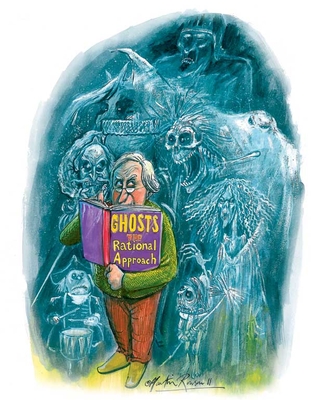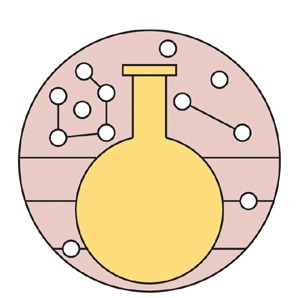
Thankfully, the results from national surveys have yielded more clear-cut findings. Opinion polls from the past 30 years or so have consistently shown that around 30 per cent of people believe in ghosts and that about 15 per cent claim to have actually experienced one. For well over a century scientists have attempted to explain these strange experiences, with much of the work focusing on the psychology of suggestion.
In the late 1970s sensory scientist Michael O’Mahony from the University of California took the idea to new heights when he persuaded the BBC to undertake an ingenious version of the study during a live programme. O’Mahony constructed some mock scientific apparatus (think weird-looking large cone, masses of wires and several oscilloscopes), and managed to keep a straight face as he told viewers that this newly devised “taste trap” used “Raman Spectroscopy” to transmit smells via sound. He then proudly announced that the stimulus would be a country smell. Unfortunately, the studio audience interpreted his comments to mean “manure”, resulting in a significant amount of smutty laughter. After clarifying that they would not be broadcasting the smell of shit into people’s homes, the research team played a standard Dolby tuning tone for ten seconds. Just as the bottles in the more pedestrian versions of the study contained nothing but water, so the tone did not actually have the ability to induce smells.
Viewers were then asked to contact the television station and describe their experiences. A few hundred viewers responded, with the majority stating that they had detected a strong smell of “hay”, “grass” and “flowers”. Although they were explicitly told that the smell would not be manure-related, several people mentioned that they had detected the subtle hint of silage. Many respondents described how the tone had brought about more dramatic symptoms, including hay fever attacks, sudden bouts of sneezing and dizziness.
These types of experiments demonstrate how nothing more than the power of expectation can cause some people to experience various smells. Psychologist James Houran believes that they may also play a vital role in unlocking the mystery of hauntings. James is an interesting fellow. During the day this mild-mannered statistician works for a well-known internet dating site creating mathematical models that help promote compatibility. By night Houran transforms into a real life ghost-buster, conducting experiments that aim to solve the mystery of hauntings.
Houran speculated that if suggestible people believe that they are in a haunted house, they may experience the strange sensations typically attributed to ghostly activity. In addition, he noted that those experiences are likely to create a feeling of fear that will cause people to become hyper-vigilant and pay attention to the subtlest of signals. They will suddenly notice that tiny creak in the floorboards, the swaying of the curtains, or a brief whiff of burning. All of this will cause them to become even more afraid and therefore exhibit even greater hyper-vigilance. The process feeds on itself until the person starts to become highly agitated, anxious and prone to more extreme sensations and hallucinations.
Houran has conducted several experiments to test his ideas. In one study he took over a disused theatre that had absolutely no reputation for being haunted, and asked two groups of people to walk around it and report how they felt. Houran told one group that the theatre was associated with lots of ghostly activity and the other that the building was simply undergoing renovation. Those in the “this building is haunted” group reported weird sensations all over the place, while the other group experienced nothing unusual. In another study Houran asked a married couple living in a house that had no reputation for ghostly activity to spend a month making a note of any “unusual occurrences” that they noticed in their home. Reporting the results in the paper “Diary of events in a thoroughly unhaunted house”, he noted that the couple reported an amazing 22 weird events, including the inexplicable malfunctioning of their telephone, their name being muttered by a ghostly presence, and the strange movement of a souvenir voodoo mask along a shelf.
Although the psychology of suggestion accounts for many ghostly phenomena, there still exists one final mystery – why on earth should our sophisticated brains have evolved to detect non-existent ghostly entities?
Scientists have proposed various theories to account for what goes bump in our minds. Psychologist Jesse Bering from the University of Arkansas has suggested that both ghosts and God help forge a more honest society by convincing people that they are constantly being watched. Bering and his team tested their idea by carrying out a somewhat strange experiment. In their study, students were asked to complete an intelligence test. The test had been carefully constructed to ensure that the students could cheat if they wanted to, and that the experimenters could secretly monitor each person’s level of deception. Just before taking the test, a randomly selected group of the students were told that the test room was apparently haunted. As predicted by the “ghosts make people more honest” theory, the students who thought that they were in a haunted room were far less likely to cheat on the test.
However, perhaps the most popular theory to account for the evolution of ghostly experiences concerns the “Hypersensitive Agency Detection Device”. Oxford University psychologist Justin Barrett believes that the idea of “agency” – being able to figure out why people act the way they do – is essential to our everyday interactions with one another. In fact, it is so important that Barrett thinks the part of the brain responsible for detecting such agency often goes into overdrive, causing people to see human-like behaviour in even the most meaningless stimuli. In the 1940s psychologists Fritz Heider and Mary-Ann Simmel conducted a now classic experiment that provides a beautiful illustration of Barrett’s point. Heider and Simmel created a short cartoon animation in which a large triangle, small triangle and a circle moved in and out of a box. They then showed the meaningless cartoon to people and asked them to describe what was happening. Most people instantly created elaborate stories to explain the cartoon, saying, for example, that perhaps the circle was in love with the little triangle, and the big triangle was attempting to steal away the circle, but that the little triangle fought back, and the small triangle and circle eventually lived happily ever after.
In short, people saw agency where none existed. Barrett believes that the same concept helps explain God, ghosts and goblins. According to the theory, many people are very reluctant to think that certain events are meaningless, and are all too eager to assume that they are the work of invisible entities. They might, for instance, experience an amazing stroke of good luck and assume it is angels at work, be struck down with an illness and see it as evidence of demons, or hear a creaking door and attribute it to a ghostly woman in white. If Barrett is right, ghosts are not the result of superstitious thinking. Neither are they spirits returning from the dead. Instead, they are simply the price we pay for having remarkable brains that can effortlessly figure out why other people behave the way they do.
Richard Wiseman's new book, Paranormality: Why We See What Isn't There, is published by Macmillan in March.
Read Richard Wiseman's ghost survey to find out which is the most haunted part of the UK
This piece is from the March/April 2011 issue of New Humanist. Subscribe

